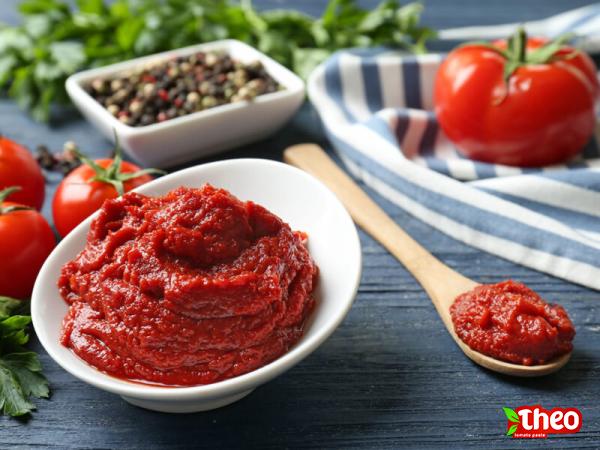The Importance of Safe Tomato Paste: Ensuring Quality and Consumer Well-being Introduction: Tomato paste is a versatile ingredient that adds depth and richness to a wide variety of dishes. However, like any food product, ensuring the safety and quality of tomato paste is of utmost importance to protect consumers’ health and well-being. In this summary, we will explore the various aspects of safe tomato paste, including the potential risks associated with it, quality standards, production processes, and best practices to ensure the production and consumption of safe tomato paste. Potential Risks and Challenges: 1. Microbiological Contamination: Tomato paste can serve as a breeding ground for harmful microorganisms such as bacteria, molds, and yeasts, which can lead to foodborne illnesses if consumed. It is crucial to adopt appropriate production practices and storage conditions to prevent microbial growth and ensure product safety. 2. Additives and Preservatives: While some preservatives and additives can be used in tomato paste production to extend its shelf life and enhance its flavor and color, the use of excessive or unauthorized additives can pose health risks to consumers. Striking a balance between the use of additives and preserving the natural qualities of the tomato paste is essential. Quality Standards for Tomato Paste: 1. International Standards: Several international regulatory bodies, such as the Food and Agriculture Organization (FAO) and the World Health Organization (WHO), have developed specific standards and guidelines to regulate the safety and quality of tomato paste. These standards address various factors, including tomato quality, processing, packaging, labeling, and storage conditions. 2. Labeling and Ingredient Transparency: Clear and accurate labeling is essential to inform consumers about the ingredients and potential allergens present in tomato paste. Providing transparent information about the origin of tomatoes, production processes, and the absence of any harmful contaminants can help build trust and ensure consumer safety. Production Processes and Safety Measures: 1. Tomato Selection and Harvesting: The quality and safety of tomato paste largely depend on the selection and harvesting of high-quality tomatoes. Proper harvesting techniques, such as picking ripe, undamaged, and disease-free tomatoes, are crucial to minimize the risk of contamination. 2. Processing Methods: Various processing methods, such as hot break and cold break, are used to make tomato paste. These processes involve crushing, straining, heating, and concentrating tomatoes to form a paste. Implementing stringent processing controls, including temperature monitoring, filtration, and sanitization, is vital to kill bacteria, enzymes, and any potential pathogens. 3. Packaging and Storage: Adequate packaging and storage play a significant role in preserving the quality and safety of tomato paste. Packaging materials should be non-reactive and designed to withstand the product’s acidity and natural enzymes. Furthermore, proper storage conditions, such as maintaining temperature and humidity levels, are essential to prevent microbial growth and extend the product’s shelf life.

tomato paste
 Best Practices for Safe Tomato Paste Consumption: 1. Purchasing from Reputable Brands: Choosing tomato paste from reputable brands or manufacturers with proper quality control measures and compliance with international standards can significantly reduce the risks associated with unsafe products. 2. Storage and Expiry Date Awareness: Consumers should store tomato paste in cool, dry places away from direct sunlight and ensure they check the expiry date before use. Using expired or damaged tomato paste can lead to food poisoning or reduced taste and quality. 3. Proper Usage and Handling: Following recommended portions and avoiding cross-contamination during preparation can minimize the risk of foodborne illnesses. Additionally, refrigerating any unused portion promptly is crucial to maintain the product’s freshness. Conclusion: Safe tomato paste production and consumption are vital to protect consumers’ health and promote overall well-being. By adhering to internationally recognized quality standards, implementing appropriate production practices, and adopting responsible handling and storage methods, the risks associated with tomato paste can be significantly reduced. Ultimately, consumer awareness and informed choices play a crucial role in ensuring the safety and enjoyment of this versatile culinary ingredient.The Importance of Safe Tomato Paste: Ensuring Quality and Consumer Well-being I. Introduction Tomato paste is a widely used ingredient in many cuisines around the world, known for its intense flavor and versatility. However, as with any food product, ensuring the safety and quality of tomato paste is paramount to protect consumers’ health and well-being. In this article, we will delve into the importance of safe tomato paste and explore various factors that contribute to its safety in a business context.
Best Practices for Safe Tomato Paste Consumption: 1. Purchasing from Reputable Brands: Choosing tomato paste from reputable brands or manufacturers with proper quality control measures and compliance with international standards can significantly reduce the risks associated with unsafe products. 2. Storage and Expiry Date Awareness: Consumers should store tomato paste in cool, dry places away from direct sunlight and ensure they check the expiry date before use. Using expired or damaged tomato paste can lead to food poisoning or reduced taste and quality. 3. Proper Usage and Handling: Following recommended portions and avoiding cross-contamination during preparation can minimize the risk of foodborne illnesses. Additionally, refrigerating any unused portion promptly is crucial to maintain the product’s freshness. Conclusion: Safe tomato paste production and consumption are vital to protect consumers’ health and promote overall well-being. By adhering to internationally recognized quality standards, implementing appropriate production practices, and adopting responsible handling and storage methods, the risks associated with tomato paste can be significantly reduced. Ultimately, consumer awareness and informed choices play a crucial role in ensuring the safety and enjoyment of this versatile culinary ingredient.The Importance of Safe Tomato Paste: Ensuring Quality and Consumer Well-being I. Introduction Tomato paste is a widely used ingredient in many cuisines around the world, known for its intense flavor and versatility. However, as with any food product, ensuring the safety and quality of tomato paste is paramount to protect consumers’ health and well-being. In this article, we will delve into the importance of safe tomato paste and explore various factors that contribute to its safety in a business context.
Specifications of tomato paste
 II. Market Demand and Consumer Concerns The demand for tomato paste has been steadily increasing in recent years, driven by the growing popularity of international cuisines and the convenience of using processed ingredients. However, consumers have also become increasingly concerned about the safety and quality of the products they consume. As a result, businesses operating in the tomato paste industry must prioritize the production of safe and reliable products to meet consumer expectations. III. Regulatory Compliance and Quality Assurance In order to ensure the safety of tomato paste, businesses must comply with rigorous regulatory standards and implement robust quality assurance practices throughout the production and supply chain. Compliance with international standards, such as those set by the FAO and WHO, is crucial to reassure consumers that the product meets established safety guidelines. IV. Supplier Selection and Quality Control One of the key steps towards producing safe tomato paste is selecting reliable and reputable suppliers of raw tomatoes. Businesses should conduct thorough evaluations of potential suppliers, assessing factors such as their farming methods, adherence to agricultural best practices, and commitment to food safety. Implementing strict quality control measures at every stage of the supply chain, from farm to processing facility, is essential to prevent potential contamination and ensure the safety of the final product. V. Good Manufacturing Practices (GMP) and Sanitation Adhering to Good Manufacturing Practices (GMP) is crucial for businesses involved in tomato paste production. GMP guidelines outline best practices in terms of facility design, equipment maintenance, hygiene protocols, and employee training. Effective sanitation procedures, such as regular cleaning and sterilization of equipment, play a vital role in preventing the growth of harmful bacteria and other contaminants. VI. Traceability and Transparency Building consumer trust and confidence in tomato paste products requires a commitment to transparency and traceability. Businesses should establish traceability systems that allow for the identification and tracking of raw materials throughout the production process. This enables prompt identification and mitigation of any potential quality or safety issues, as well as providing consumers with the assurance that the product they are purchasing is safe and of high quality.
II. Market Demand and Consumer Concerns The demand for tomato paste has been steadily increasing in recent years, driven by the growing popularity of international cuisines and the convenience of using processed ingredients. However, consumers have also become increasingly concerned about the safety and quality of the products they consume. As a result, businesses operating in the tomato paste industry must prioritize the production of safe and reliable products to meet consumer expectations. III. Regulatory Compliance and Quality Assurance In order to ensure the safety of tomato paste, businesses must comply with rigorous regulatory standards and implement robust quality assurance practices throughout the production and supply chain. Compliance with international standards, such as those set by the FAO and WHO, is crucial to reassure consumers that the product meets established safety guidelines. IV. Supplier Selection and Quality Control One of the key steps towards producing safe tomato paste is selecting reliable and reputable suppliers of raw tomatoes. Businesses should conduct thorough evaluations of potential suppliers, assessing factors such as their farming methods, adherence to agricultural best practices, and commitment to food safety. Implementing strict quality control measures at every stage of the supply chain, from farm to processing facility, is essential to prevent potential contamination and ensure the safety of the final product. V. Good Manufacturing Practices (GMP) and Sanitation Adhering to Good Manufacturing Practices (GMP) is crucial for businesses involved in tomato paste production. GMP guidelines outline best practices in terms of facility design, equipment maintenance, hygiene protocols, and employee training. Effective sanitation procedures, such as regular cleaning and sterilization of equipment, play a vital role in preventing the growth of harmful bacteria and other contaminants. VI. Traceability and Transparency Building consumer trust and confidence in tomato paste products requires a commitment to transparency and traceability. Businesses should establish traceability systems that allow for the identification and tracking of raw materials throughout the production process. This enables prompt identification and mitigation of any potential quality or safety issues, as well as providing consumers with the assurance that the product they are purchasing is safe and of high quality.
buy tomato paste
 VII. Quality Control Testing Businesses involved in tomato paste production should conduct rigorous quality control testing at various stages of the production process. This includes testing for microbial contamination, checking for the presence of harmful substances or residues, and ensuring compliance with regulatory standards. Regular monitoring and analysis of the product’s composition and quality parameters are essential to identify any potential issues and take prompt corrective actions. VIII. Packaging and Labeling Safe packaging is critical for maintaining the quality and safety of tomato paste. Packaging materials should be chosen carefully to ensure they do not interact with the product and cause contamination. Tamper-evident packaging helps in assuring consumers of the product’s integrity. Clear and accurate labeling is also necessary, providing information about the ingredients, nutritional content, allergens, and any necessary warnings. IX. Distribution and Storage Once tomato paste is produced, proper distribution and storage practices are necessary to maintain its quality and safety until it reaches the consumer. Businesses must ensure that the product is stored and transported within appropriate temperature and humidity conditions, minimizing the risk of microbial growth. Close monitoring of the supply chain and implementing suitable measures to prevent product tampering are also essential to maintain the product’s safety. X. Consumer Education and Engagement Businesses have a responsibility to educate consumers about the importance of safe tomato paste and how to identify reliable and quality products. Providing clear and accessible information about the production process, safety measures, and quality standards can empower consumers to make informed decisions and choose products that meet their expectations. Engaging with consumers through social media platforms and other channels can further enhance communication and trust. XI. Continuous Improvement and Innovation Ensuring the safety of tomato paste is an ongoing commitment that requires continuous improvement and innovation. Businesses should stay updated with the latest scientific research, technological advancements, and regulatory updates to enhance their production processes and quality assurance measures. Implementing new technologies, such as blockchain, can also help enhance traceability and transparency within the supply chain. XII. Conclusion Safe tomato paste production is a crucial aspect of the food industry, ensuring consumer well-being and satisfaction. Businesses operating in this sector must prioritize adherence to regulatory standards, implement robust quality control measures, and maintain transparency throughout the supply chain. By doing so, they can build trust with consumers and contribute to a safer and more sustainable tomato paste industry.
VII. Quality Control Testing Businesses involved in tomato paste production should conduct rigorous quality control testing at various stages of the production process. This includes testing for microbial contamination, checking for the presence of harmful substances or residues, and ensuring compliance with regulatory standards. Regular monitoring and analysis of the product’s composition and quality parameters are essential to identify any potential issues and take prompt corrective actions. VIII. Packaging and Labeling Safe packaging is critical for maintaining the quality and safety of tomato paste. Packaging materials should be chosen carefully to ensure they do not interact with the product and cause contamination. Tamper-evident packaging helps in assuring consumers of the product’s integrity. Clear and accurate labeling is also necessary, providing information about the ingredients, nutritional content, allergens, and any necessary warnings. IX. Distribution and Storage Once tomato paste is produced, proper distribution and storage practices are necessary to maintain its quality and safety until it reaches the consumer. Businesses must ensure that the product is stored and transported within appropriate temperature and humidity conditions, minimizing the risk of microbial growth. Close monitoring of the supply chain and implementing suitable measures to prevent product tampering are also essential to maintain the product’s safety. X. Consumer Education and Engagement Businesses have a responsibility to educate consumers about the importance of safe tomato paste and how to identify reliable and quality products. Providing clear and accessible information about the production process, safety measures, and quality standards can empower consumers to make informed decisions and choose products that meet their expectations. Engaging with consumers through social media platforms and other channels can further enhance communication and trust. XI. Continuous Improvement and Innovation Ensuring the safety of tomato paste is an ongoing commitment that requires continuous improvement and innovation. Businesses should stay updated with the latest scientific research, technological advancements, and regulatory updates to enhance their production processes and quality assurance measures. Implementing new technologies, such as blockchain, can also help enhance traceability and transparency within the supply chain. XII. Conclusion Safe tomato paste production is a crucial aspect of the food industry, ensuring consumer well-being and satisfaction. Businesses operating in this sector must prioritize adherence to regulatory standards, implement robust quality control measures, and maintain transparency throughout the supply chain. By doing so, they can build trust with consumers and contribute to a safer and more sustainable tomato paste industry.




